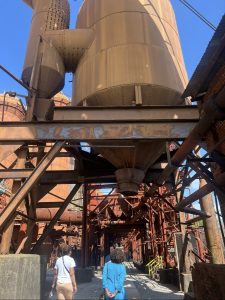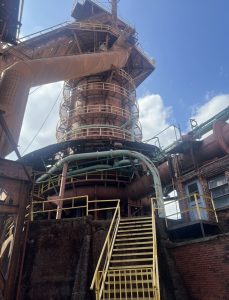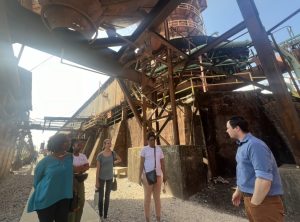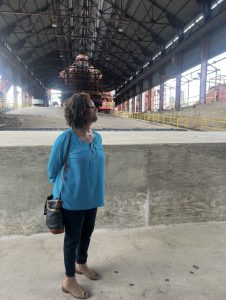As the world celebrates International Workers’ Day, commonly known as May Day, it feels crucial to reflect on the intersectionality of environmental justice and workers’ rights right here in Birmingham. Recently, the team at GASP (Greater Birmingham Alliance to Stop Pollution) embarked on a poignant journey through the historical corridors of Sloss Furnaces. We delved deep into its past and discovered the enduring implications for environmental and social justice today.
We were led by Ty Malugani, our tour guide and historian. Jilisa Milton, the Executive Director of GASP, and Barbara Jackson, the Grassroots Organizer, attended the Sloss Furnaces tour. Perry Dowell, the Climate Change Coordinator. Mychala Dawson, the Engagement Specialist, and Madison Naves, the Communications Coordinator, also joined.
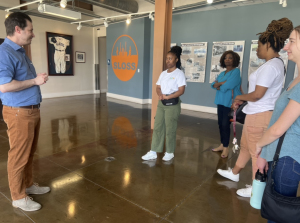
Sloss Furnace Tour Guide & Historian, Ty Malugani, Mychala Dawson, Barbara Jackson, Jilisa Miton, & Perry Dowell
In search of the historical connection between industrial pollution in Birmingham, Alabama, and the intersectionalities of Environmental Racism, we were able to understand not only the industrial legacy of Sloss Furnaces but also its profound impact on workers, particularly in the context of race and discrimination.
Sloss Furnaces was once a vibrant hub of iron production that fueled Birmingham’s growth, earning it the nickname “The Steel City.” The inoperable facility now stands as a towering symbol of Birmingham’s industrial prowess. Tourists read historical markers and plaques detailing the looming machines and conditions workers were subjected to while producing iron for the nation. However, we were fortunate enough to have Malugani guide us through the facility, which now serves as a National Historic Landmark. He unveiled through rich storytelling the dark history of the facility, muddied by exploitation, discrimination, and environmental degradation. The hazardous working conditions and the systemic racism that permeated every aspect of life for its workers, rung through the hollowed machinery like a call from familiar ancestors.
The history lesson was a sobering reminder of the enduring legacy of environmental injustice. Sloss Furnaces, like many industrial sites of its time, relied heavily on the labor of marginalized communities, particularly African Americans, who were subjected to deplorable working conditions and blatant disregard for their well-being. The lack of concern for worker safety was palpable, as workers were denied proper protective gear unless they purchased it themselves. This callous disregard for human life was compounded by the use of forced labor, with some facilities under Sloss Furnaces’ control being operated by chain gangs compromised of falsely imprisoned individuals, victims of the harsh and racist laws of the Jim Crow era.

National Historic Landmark detailing the racial violence that took place on Sloss Furnaces owned campuses.
The racial divide that permeated Sloss Furnaces was not merely a product of its time but a deliberate strategy to maintain power and control. Black workers, relegated to the lowest rungs of the industrial hierarchy, were not only paid less than their white counterparts but were also subjected to horrendous working conditions and degrading treatment. Facilities were segregated along racial lines, with black workers relegated to substandard accommodations and inferior facilities.
The conditions within these facilities were nothing short of deplorable, especially on Sloss-owned facilities that were run by using forced labor to overwork and abuse those imprisoned by unfair laws based on stereotypes and prejudice against black people. Inmates, coerced into labor under threat of further punishment, endured grueling work hours under the scorching heat of molten metal, their humanity stripped away in service of corporate profit.
Yet, the specter of violence loomed large over Sloss Furnaces, resulting in the tragic murder of a worker whose life was cut short in a senseless act of brutality. This grim reality is a stark reminder of the human cost of unchecked greed and systemic oppression, a stain on the collective conscience of a city built on the backs of the oppressed. The furnace, with its billowing smokestacks and relentless production, was a testament to the sacrifice of these workers, whose voices were often silenced in the pursuit of profit.
As we stood amidst the rusted remnants of machinery, we saw a clear distinction in the struggle for equality and justice that is not confined to the pages of history but is an ongoing battle that demands our unwavering commitment and solidarity.
The legacy of environmental injustice persists in our communities today, disproportionately impacting marginalized groups who bear the brunt of pollution, climate change, and industrial exploitation. May Day is a poignant reminder of the ongoing struggle for workers’ rights and environmental justice intertwined in a complex web of systemic inequality.
For GASP, the visit to Sloss Furnaces catalyzed action, reaffirming our commitment to advocacy and activism to pursue a just and equitable future. We recognize that in the fight for environmental justice, we cannot ignore the broader struggle for social and economic equality. It requires us to confront the legacies of racism and discrimination embedded in our industrial heritage and to challenge the systems that perpetuate injustice.
As we commemorate International Workers’ Day, let us honor the sacrifices of those who came before us and recommit ourselves to the pursuit of justice for all. May the echoes of the past serve as a rallying cry for a brighter, more equitable future, where every worker is valued, and every community is empowered to thrive in harmony with the environment.



